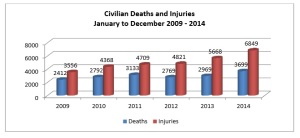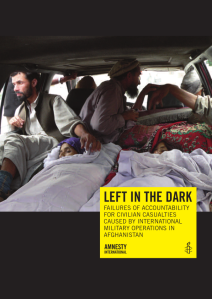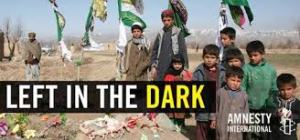Legal Accountability for Civilian Casualties in Afghanistan
by tagregory
The pain and suffering experienced by civilians continues to be a major point of contention in Afghanistan despite the slow but steady withdrawal of coalition troops. A recent report by the United Nations Assistance Mission in Afghanistan (UNAMA) found that 10,548 civilians were killed and injured (3,699 deaths, 6,849 injured) in 2014, which represents an increase of 22% compared to 2013. As Nicholas Haysom, UN Special representative of the Secretary-General in Afghanistan, argued:
The conflict took an extreme toll on civilians in 2014. Mortars, IEDs, gunfire and other explosives destroyed human life, stole limbs and ruined lives at unprecedented levels. The thousands of Afghan children, women and men killed and injured in 2014 attest to failures to protect civilians from harm. All parties must uphold the values they claim to defend and make protecting civilians their first priority.
 The report attributes the rise to the increased use of high-explosive weaponry, such as mortars, rockets and grenades, in densely populated civilian areas. The overwhelming majority of civilian casualties (72%) were attributed to anti-government forces, but pro-government forces – which include international troops – were responsible for 14% of the attacks. Another 3% was blamed on ‘unattributed explosive remnants of war’, which probably includes the thousands of bright yellow cluster bombs that were left scattered across Afghanistan by the United States during the early stages of Operation Enduring Freedom.
The report attributes the rise to the increased use of high-explosive weaponry, such as mortars, rockets and grenades, in densely populated civilian areas. The overwhelming majority of civilian casualties (72%) were attributed to anti-government forces, but pro-government forces – which include international troops – were responsible for 14% of the attacks. Another 3% was blamed on ‘unattributed explosive remnants of war’, which probably includes the thousands of bright yellow cluster bombs that were left scattered across Afghanistan by the United States during the early stages of Operation Enduring Freedom.
The Costs of War project puts the total number of civilians killed at 21,000, although this data only runs up until 2011. With the conclusion of Operation Enduring Freedom and the start of Operation Resolute Support, the issue of civilian harm continues to be a contentious point. To coincide with the end of combat operations, Amnesty International published details of a lengthy investigation into non-combatant casualties caused by coalition troops.
The report, entitled “Left in the Dark: Failures of Accountability for Civilian Casualties Caused by Military Operations in Afghanistan”, details the myriad of problems that Afghan civilians face when trying to get justice for those killed in combat operations. These range from the failure of US forces to investigate incidents where civilians have been killed, to the almost total secrecy that surround those investigations that are underway.
 Even in cases where there is clear evidence that the killings were unlawful, family members quickly discovered that they had no recourse to the law. On the one hand, coalition troops are immune from prosecution under Afghan law, which means that legal proceedings cannot be initiated with Afghanistan. On the other hand, Amnesty found that complaints to coalition authorities were often ignored, even when criminal investigations were promised. ‘In numerous cases in which there is credible evidence of unlawful killings of civilians, the military has failed to conduct prompt, thorough and impartial investigations’, the report argues.
Even in cases where there is clear evidence that the killings were unlawful, family members quickly discovered that they had no recourse to the law. On the one hand, coalition troops are immune from prosecution under Afghan law, which means that legal proceedings cannot be initiated with Afghanistan. On the other hand, Amnesty found that complaints to coalition authorities were often ignored, even when criminal investigations were promised. ‘In numerous cases in which there is credible evidence of unlawful killings of civilians, the military has failed to conduct prompt, thorough and impartial investigations’, the report argues.
The reason for this failure of accountability can be found in the ’structural flaws’ that underpin US military justice. The report argues that the justice system is ‘commander-driven’ to the extent that evidence of wrongdoing largely depends on observations made by soldiers of the ground. Not surprisingly, there is little incentive for soldiers to report evidence of wrongdoing that may incriminate themselves or their colleagues and the commanding officer has even less of an incentive to report possible violations that may reflect poorly on his or her own conduct. As the report makes clear, ‘it is only in the rarest of circumstances – where fellow soldiers are so appalled by another soldier’s behaviour that they insist on reporting it up the chain of command […] – that criminal cases involving civilian casualties go forward’.
The rest of the report consists of various case-studies that all illustrate the lack of accountability, from nine boys killed by a US helicopter in the province of Kunar to various night raids by special-ops that have resulted in death and injury. Based on interviews with survivors, family members and NGOs, the report documents the various failures of justice. In some cases news of civilian casualties was simply dismissed as Taliban propaganda and ignored; in others apologies were offered and investigations were promised. On a number of occasions, victims were so worried that their voices would be ignored that they loaded the dead bodies on to the back of a pick-up truck and transported them to the local authorities to provide physical evidence of the attacks (see also).
Despite this, the report makes clear that ‘very few cases involving the alleged unlawful killings of civilians in international military operations have led to prosecutions’ and that the relatives left behind ‘face numerous obstacles to justice, both structural and physical’. Investigators were aware of only six incidents that have gone to trial since 2009 and these were all high-profile incidents involving extraordinary acts of violence, such as the deliberate targeting of innocent civilians and subsequent desecration of their bodies by members of the Afghan Kill Team. It is easy to forget that the vast majority of civilians die a far less spectacular death and so tend to be ignored by both military investigators and the world’s media.